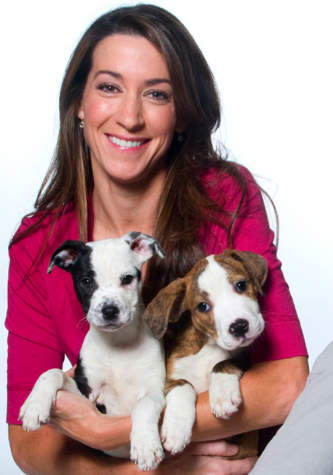A hug by any other name is still as sweet, just not to most dogs. Hugging is a common way that people express affection, so it is not surprising that we want to hug our pups. Unfortunately, the way that people express affection is often at odds with what dogs are comfortable with.
Ventral to ventral (i.e. chest to chest) contact is something you might occasionally see as two dogs play (especially Boxers!). But, this is rare. Even more rare is the sight of two dogs with arms wrapped around each other in a tight, prolonged hug. Yet, people want to hug their dogs on a daily basis.
Consideration should be given to the fact that dogs are a different species than us, and as such adhere to a very different code of polite conduct. The restraint implicit in a hug is not an indicative of affection in the canine world. But, there is no getting around the fact that in choosing to have dogs as part of our families, they must learn to be accepting of some of the ways of humans. This includes hugging or at least restraint.
Certainly, some dogs will develop a trusting bond with their people to the extent that prolonged hugs are much appreciated. However, even if a dog doesn’t eventually have hugs high on their hit list of favorite activities, they should learn to be accepting of restraint.
Teaching your pup to tolerate being restrained is less about being able to hug them for your pleasure and more about ensuring you can restrain them for their safety without them struggling to get free. Imagine a fight breaking out in the dog run, or if your dog is injured and needs to be carried to the veterinarian’s office.
Plan for many brief (3-5 minute) practice sessions a day, and do your best to go at a pace that is appropriate for your pup. Attempting to rush and force your dog to be accepting of handling of any sort, but especially restraint, is likely to result in a pup who feels pressured and stressed. Neither is conducive to trust, calm and acceptance of instruction or restraint in the future.
- Sit on the floor and hold your pup on lap.
- Gently put your hands around to the front of or under your dog’s chest for a 2-3 second loose hold and offer a treat.
- Gradually increase the length of the loose hold and calmly massage your pup’s chest.
- Decrease the length of the hold as you gradually increase intensity of the hold. Continue to reinforce with food for each hold.
- When your dog is calm and relaxed with a brief, slightly more intense hold you can gradually increase the duration again.
If your pup struggles, recognize this as a sign that you went beyond the pup’s tolerance threshold and need to decrease the duration and/or intensity of the restraint and up the reward so your pup is less likely to struggle next time. Practice in as many places as possible and enlist the assistance of family and friends to help your pup to become a hug-happy hound.
Andrea Arden isan animal behavior counselor, rescuer, author, speaker, and a resident pet expert on the Today Show. For more information, check out her website, AndreaArden.com or read all Project Puppy installments.









